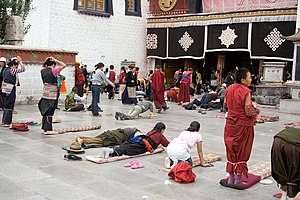Tibetan festivals
Appearance
The article's lead section may need to be rewritten. (October 2014) |
| Part of a series on |
| Tibetan Buddhism |
|---|
 |
In Tibet, the Tibetan calendar lags approximately four to six weeks behind the solar calendar. For example, the Tibetan First Month usually falls in February, the Fifth Month usually falls in June or early July and the Eight Month usually falls in September.
List of traditional Tibetan festivals
| Month | Date | Festival | Notes |
|---|---|---|---|
| 1st Month | 1st-7th | New Year Festival Losar | A week-long drama and carnivals, horse races and archery |
| 1st Month | 4th-25th | Monlam Prayer Festival | The Great Prayer Festival, a tradition begun by Tsong Khapa. Many pilgrims gather at Jokhang in Lhasa |
| 1st Month | 15th | Lantern Festival | Commemorates Buddha's miracle at Sravasti. Fires are lit on roofs, and lamps in windows |
| 2nd Month | 28th-29th | - | Festival to drive out evil spirits and expel the scapegoat. Lamas encircle Lhasa with trumpets |
| 4th Month | 7th | Pilgrim Festival | Important month for pilgrims. -the birth of Buddha Sakyamuni |
| 4th Month | 15th | Saka dawa | Celebrates the birth and Enlightenment of Sakyamuni and his entry to Nirvana. An outdoor opera is held and captured animals released. Worshippers flock to the Jokhang in Lhasa to pray. |
| 5th Month | 14th-16th | Hanging of the Thangka | A giant thangka is hung at Tashilhunpo in Shigatse |
| 5th Month | 15th | Incense Festival | On this day ghosts are said to prowl. Tibetans dress up and party to drive away the spirits. |
| 5th Month | 15th-24th | Sho Dun Festival | Literally, the "Yoghurt Festival." Worship of the Buddha. Picnics and operas are held in parks particularly under the trees at Norbulingka. There are often bonfires at night. |
| 6th Month | 4th | Buddha's sermon | A feast is held to commemorate Buddha's first sermon. Pilgrims climb holy mountains such as Chokbori |
| 6th month | 6th | Cham-ngyon-wa, or "Old Dance" | Celebrated at the Cho-ne Monastery, representing the souls of the departed. |
| 7th month | beginning | Washing Festival | Lasts about a week. People go to the river to wash themselves and their clothes. Said to cure any sickness. |
| 7th Month | end | Ongkar Festival | Literally 'Looking around the fields'. Ensures a good harvest. Horse-racing, archery contests and opera |
| 7th/8th Month | All | Golden Star Festival | The Golden Star festival is held to wash away passion, greed and jealousy and to abandon ego. Ritual bathing in rivers takes place and picnics are held |
| 8th Month | 1st-10th | Dajyur Festival | The Dayjur is held in Gyantse and Damxung -horse racing and light hearted sports competitions and games takes places |
| 8th Month | 1st-7th | Harvest Festival | The festival is held with prayers, dancing, singing and drinking |
| 9th Month | 22nd | - | Buddha's descent from heaven after preaching to his mother is commemorated. All monasteries are opened and pilgrims gather |
| 10th Month | 25th | Tsong Khapa memorial | Memorial festival of Tsong Khapa's death - fires are lit on the roofs of the monasteries and lamps are lit |
| 12th Month | 1st-7th | New Year Festival | New Year Festival in Shigatse |
| 12th Month | 5th-6th | Meeting of the Eight Guardians | The Meeting of the Eight Guardians and demons where Tibetans stay indoors to avoid evil outside |
| 12th Month | 29th | Banishing Evil Spirits | A "Devil Dance" is held to drive out all evil from the Old Year to prepare for New Year. |
Losar
The Tibetan calendar is a lunisolar calendar. Losar is celebrated on the first three days of the first lunar month.
| Gregorian year | Tibetan year | Losar* | element and animal |
|---|---|---|---|
| 2000 | 2126 | February 5 - February 7 | male iron dragon |
| 2001 | 2127 | January 24 - January 26 | female iron snake (or metal serpent) |
| 2002 | 2128 | February 12 - February 14 | male water horse |
| 2003 | 2129 | February 1 - February 3 | female water sheep (or goat) |
| 2004 | 2130 | January 22 - January 24 | male wood monkey |
| 2005 | 2131 | February 9 - February 11* | female wood bird (or rooster) |
| 2006 | 2132 | January 30 - February 1 | male fire dog |
| 2007 | 2133 | February 18 - February 20 | female fire pig |
| 2008 | 2134 | February 7 - February 9 | male earth rat (some Gelukpa cite Tibetan Year 2135 [five], starting 2008-02-07 at 03:44 GMT, also an annular solar eclipse) |
| 2009 | 2135 | January 25 - January 27 | female earth ox |
Gallery


